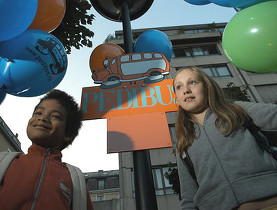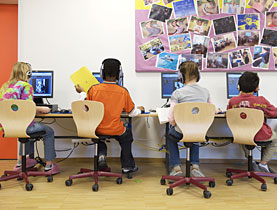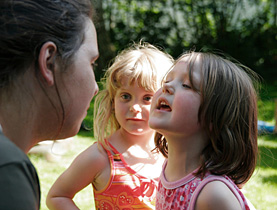All aboard for the walk to school!

Switzerland is marking International Walk to School Day on Friday to highlight the road safety issues children face on their way to school.
swissinfo joined a “walking school bus” of a dozen children in Lausanne to find out why Swiss kids are more apt to walk than youngsters in many other industrialised countries.
“In twos. Hold hands. Ready? We’re off!” It is just after eight o’clock in the morning as the 12 children in this walking school bus make their way to Pierrefleur primary school.
Studies indicate that worldwide fewer children are walking and cycling to school. Swiss children seem to be bucking this trend, however.
In Switzerland walking is still the most important mode of transport during the period of compulsory schooling. Seven out of ten primary school children walk to school, compared with only ten per cent of schoolchildren in the United States.
In Britain just over half of trips to school by five to ten year olds were made on foot whereas 41 per cent are made by car.
Walking to and from school increased significantly between 2000-2005 in Switzerland’s French-speaking areas due to promotional campaigns and is now at a similar level to German-speaking regions.
According to Daniel Sauter, the author of a study into the mobility of Swiss children and adolescents, there is a long tradition of walking to school in Switzerland.
“It has to do with the closeness of schools and most kids don’t have to walk very far,” he told swissinfo. “Cities have many zones with maximum speed limit of 30km per hour and we have large enough sidewalks allowing kids to walk side by side.”
But there are still problems with crossings on main, cantonal roads and it is still difficult to convince the authorities to implement measures to slow down car traffic and give schoolchildren higher priority, he said.
Road safety and solidarity
Five minutes into our journey through the tranquil Chablière residential district, the fast pace slackens as we stop to pick up new young passengers and I get time to ask Catherine Zaccaria, coordinator of Lausanne’s 32 walking school bus routes, why the ten-year-old scheme has been so successful.
“The project has the ability not only to reply to road safety concerns, but also to create ties between people living in the local area – there’s the whole notion of solidarity and conviviality,” she said.
Two fathers wave goodbye to their children as the bus – a dozen six-to-seven-year olds accompanied by three mothers – scampers off towards the main road.
“The project has to be seen as part of the notion of accompanying young children in an urban setting,” said Zaccaria. “The city coaches and the parents manage. It’s a learning process becoming autonomous, being able to manage your journey to school alone.”
The scheme has different steps, she explained.
“When they are young kids, adults are responsible for them and make them aware of the dangers. But as they get older they learn to become independent and, under the responsibility of an adult, help to ‘drive’ the group to school,” said Zaccaria.
Although the aim of the walking school bus should be to have fewer car journeys and more children eventually walking to school on their own, Sauter said he knew certain local authorities that were happy there was a walking school bus because “they didn’t have to change the infrastructure”.
“They can keep their roads unchanged because they know there will always be one or two parents keeping watch over the children,” he said.
Out of the question
Marshalled by the three parents, the bus skips across the zebra crossing on the busy Avenue de la Vallombreuse.
“The next part is dangerous for kids as the path is narrow and cars go fast. And especially at that age they don’t realise the dangers,” explained mother Laura Richon.
Letting her son, six-year-old Sven, walk to school on his own is out of the question.
“Up to the age of nine they don’t realise the dangers. It’s not prudent. Maybe in a small village where everyone knows each other but not in a town where people have an early-morning stress,” she said.
The well-drilled pack crosses the narrow road safely and continues uphill, weaving its way behind large private houses on the half-a-kilometre-long route.
“The walking school bus is really physical,” said Zaccaria. “Walking on a daily basis can contribute to their understanding of the importance of physical activity.”
Valued support
In Switzerland, where children generally start school between 7.30 and 8.30, then go home for lunch before returning to school in the afternoon, the walking to school bus scheme has become a godsend for busy parents juggling professional and family life.
“For mums who work or with young children, it’s an extraordinary help. It’s just not possible to go to work with the hours the children have,” said Richon.
“Or if you are on your own it’s tough, as you take them to school. You hardly have time to get home and then you have to go back for them.”
The young mother is convinced that life would be more complicated without the bus scheme.
“It would be a headache. We’d take them to school by car, of course, which would be bad for the environment and we’d have to find day-care help, the grandmother or neighbour to help out. It’s really complicated,” she said.
It’s 8.25am. The bus has reached its destination – Pierrefleur primary school – on time and safe and sound. The children say a final farewell to the three “drivers” before lining up ready for the start of class.
swissinfo, Simon Bradley in Lausanne
Millions of children and parents in over 40 countries participated in 2007 in the International Walk to School event, now in it’s ninth year.
The exact day differs from country to country, taking into account school holidays.
In French and Italian-speaking Switzerland, about 200 schools in 130 communities are taking part in the event on September 19.
In Switzerland, 7 out of 10 primary school children still walk to school; at the secondary level, the ratio drops to around one third. Cycling and public transport become much more significant at this level.
Walking to/from school showed a marked increase in French-speaking Switzerland between 2000 and 2005 (last year of statistics). This reversal in trend could be due partly to the various activities and campaigns to encourage walking to school. The percentage of French-speaking children walking to school is about the same as in German-speaking parts.
One of the most striking changes is the decline – by over 40% – in bicycle use between 1994 and 2005. This involves both genders, all age groups from 6 to 20 years, all linguistic regions and all travel purposes.

In compliance with the JTI standards
More: SWI swissinfo.ch certified by the Journalism Trust Initiative




You can find an overview of ongoing debates with our journalists here. Please join us!
If you want to start a conversation about a topic raised in this article or want to report factual errors, email us at english@swissinfo.ch.